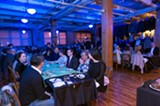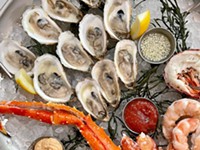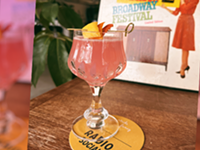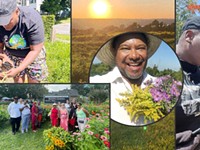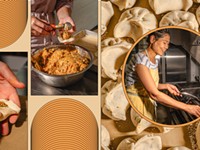[
{
"name": "500x250 Ad",
"insertPoint": "5",
"component": "15667920",
"parentWrapperClass": "",
"requiredCountToDisplay": "1"
}
]
For the last several years, RIT's Industrial Design department has charged its senior year students with a challenging opportunity to collaborate with designers and design houses for its Metaproject. The program creates industry partnerships for students with different established companies, which in the past have included Umbra, Poppin, and Kikkerland. And it allows students the chance to shine on the professional, international stage, as the department showcases the final products of the Metaproject at New York's Design Week each May.
The latest iteration of the project, "Designing Dining," which took place last Sunday night at Restaurant Good Luck, wasn't products designed by each individual student, but a collaborative experience: a four-course meal in a pop-up restaurant within a restaurant, designed by the 16 industrial design students and one interior design student consultant. The event also served as part of Good Luck's series of Inspired Table dinners, and ticket revenue helps the students fund the experience and "message it" during Design Week.
RIT Industrial Design chair Josh Owen and project collaborator, Good Luck Co-owner Chuck Cerankosky (who is a 2003 graduate of the ID program), and chef Dan Martello worked closely with the students after they were given their directive in the fall.
"We've designed everything from toys to the future of office systems," Owen says of past Metaprojects. "These are kids who are trained as product designers, but the definition of product design has certainly expanded beyond the traditional definition into experience, socially-conscious community work, and systems design. This was an opportunity to test it out on an experience to be consumed and all done in a short period of time."
Every bit of the evening was carefully curated. Cerulean lights cast a club-like glow on everything as chatter rose over the DJ's spinning and guests sipped the signature drink, a vibrant cocktail made with Blue Curacao. Signage in bold, tightly-kerned Helvetica (naturally) decked the walls.
At coat check, the students exchanged guests' outerwear for a numbered clothespin, and proceeded to adhere the coats to a clothesline and use a pulley system to string them up high across the glass window wall that divides the bar from the dining room. When my plus-one joked that they'd effectively trapped us inside for the duration of the event — it was far too bitter to go outside unswaddled — I recalled that my smokes were in my coat pocket and winced as I asked them to bring it back so I could get a quick one in.
Assigned seating at two long tables in the dining room had me placed across from my friend, each of us flanked by ID department alum and current RIT staff. The experience was meant to be a form of "communal dining," but when one diner suggested we get new neighbors by moving around between courses a la the Mad Hatter's tea party, no one was really having it.
Before each of the courses, there was a performative aspect as the students changed the look of the tabletops by unrolling a runner down the center of the long surfaces. Each of the materials used were matched to the courses, which subtly alluded to the seasons, moving from spring through winter. Coasters printed with different phrases were also changed between courses: "a time for growth," "a chill in the air," and so on.
A burlap runner preceded the salad course, which was a literal bouquet of greens and edible flowers packaged in paper that diners unwrapped before dousing with dressing served in watering cans. A layer of fishnet was added next, prompting guests to speculate that seafood was coming. And it was, served on upright skewers stood on blocks of wood. A fun touch — we were given a squirt tube of sauce and asked to write a word on our plates that encapsulates summer — was just one of a few Instagram opportunities.
As diners conversed between courses, another performative aspect was happening on the back wall, where the restaurant's massive chalk board was covered with white paper. Throughout the meal, students made colorful prints using cut vegetables, and later removed paper letters to reveal "Designing Dining" in negative space.
The third course was a hearty meal of cider-braised chicken, squash, potato puree, and Brussels sprouts, served family-style on large platters that diners passed around. Just before the final course, a heat sensitive black vinyl runner was unrolled, prompting much giggling as guests made hand prints and snapped photographs. Soon we were each served a sort of deconstructed, frozen apple pie: a shortbread cookie on a bed of spiced ice with a vessel of hot caramel to thaw it.
The evening was a compelling, playful, social event, and cohesive despite the disparate elements and the many hands on deck. Owen says he's not sure how this experience will manifest during Design Week — typically they have a space showcasing the students' products — but it's something they're working out. Not only was the topic a bit of a stretch, but the implementation was a group effort, he says. "These kids really are capable of being expansive in their thinking about how to deliver experiences."
Speaking of...
Latest in Culture
More by Rebecca Rafferty
-

Beyond folklore
Apr 4, 2024 -

Partnership perks: Public Provisions @ Flour City Bread
Feb 24, 2024 -

Raison d’Art
Feb 19, 2024 - More »
Readers also liked…
-
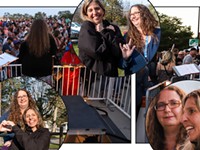
Telltale signs
May 17, 2024
